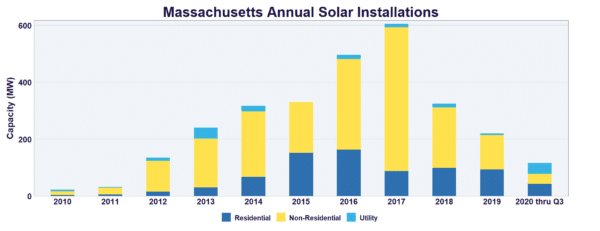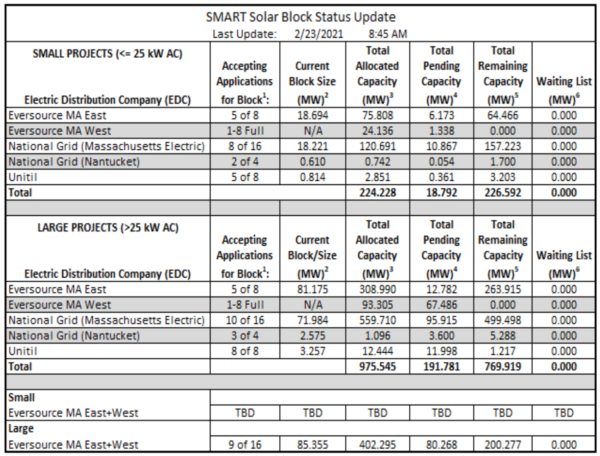The Massachusetts Department of Energy and Resources (DOER) was tasked with replacing its highly successful Solar Renewable Energy Certificate I & II programs five years ago. After a couple of band-aid extensions that allowed the SREC II program to continue, in late 2018 the agency launched the Solar Massachusetts Renewable Target (SMART) program.
The program has a broad goal of deploying 1.6 GWac (later upped to 3.2 GWac) of solar power in such a way that it is financially sound for electricity ratepayers. Project siting, economic justice, and energy storage all were considered in the equation of constructing this solar capacity.
 In the field experience of this solar developer, and many others based upon demand shortly after the new program was released, the tools deployed by DOER and the underlying contract structure have created a program that local business and homeowners can grasp, and are investing in.
In the field experience of this solar developer, and many others based upon demand shortly after the new program was released, the tools deployed by DOER and the underlying contract structure have created a program that local business and homeowners can grasp, and are investing in.
Let’s see what makes it work.
The program path within SMART that appeals most to local bankers is the Alternative On Bill Credit (AOBC) + Wholesale Power Purchase Agreement (PPA). This program is specifically designed for standalone solar projects that will sell all of their electricity to the local utility.
 In practice, the project owner signs two 20-year contracts – the ABOC and the PPA – with the state and the electric utility, respectively. The independently metered solar project begins to pay the owner via one direct deposit and one check per month about four months after the project switches on.
In practice, the project owner signs two 20-year contracts – the ABOC and the PPA – with the state and the electric utility, respectively. The independently metered solar project begins to pay the owner via one direct deposit and one check per month about four months after the project switches on.
Because these are fixed contracts with highly credible institutions, bankers see the electricity revenues as lower risk than the intermingling of incentives, and electricity bills, of the business themselves.
(Read “Bill would mandate rooftop solar on new homes and commercial buildings.”)
And, because all of the system’s electricity generation can be sold to the utility, building owners are motivated to maximize the amount of solar they are willing to deploy.
If the AOBC program within SMART sounds familiar, that’s because it shares a few aspects with Rhode Island’s REGrowth program. The key similarities are:
● Standalone solar project
● Long term, fixed value contract
● High credit offtaker (electricity utility), backed by the state.
Of course, the project’s return on investment matters as well. At a high level, Massachusetts has done a good job pricing incentives to motivate local installations. However, determining ROIs requires a bit of alchemy—combining the data of project size, utility load zone, capacity installed already, additions of energy storage and agrivoltaics, siting rules, and system efficiency—into spreadsheets.
Programs of this nature that maximize roofs with high-quality off takers are why Rhode Island and Massachusetts have significant rooftop, and distribution level, volumes of solar power deployed.
In particular, Massachusetts produces nearly 20% of its electricity from solar. That speaks volumes about the political support it receives.
John Fitzgerald Weaver is a solar power professional, known digitally as the ‘Commercial Solar Guy.’ His company has a construction license in Massachusetts, and directly manages projects in MA & RI. He may be reached at commercialsolarguy@gmail.com.
This content is protected by copyright and may not be reused. If you want to cooperate with us and would like to reuse some of our content, please contact: editors@pv-magazine.com.









By submitting this form you agree to pv magazine using your data for the purposes of publishing your comment.
Your personal data will only be disclosed or otherwise transmitted to third parties for the purposes of spam filtering or if this is necessary for technical maintenance of the website. Any other transfer to third parties will not take place unless this is justified on the basis of applicable data protection regulations or if pv magazine is legally obliged to do so.
You may revoke this consent at any time with effect for the future, in which case your personal data will be deleted immediately. Otherwise, your data will be deleted if pv magazine has processed your request or the purpose of data storage is fulfilled.
Further information on data privacy can be found in our Data Protection Policy.